Project Management Trends: How Demand for Software Features Has Changed Over Time
Project management is all about having a proper plan to execute your business goals. You put together a team of people and brainstorm to find the best ways of achieving your goals. But if you ask any project manager, they’ll tell you that managing projects—and the people involved with the projects—isn’t an easy job, which is why most businesses use project management solutions to track deliverables and deadlines.
If you’re planning to invest in project management software or upgrade the one you currently use, it’s a good idea to have a look around before making a commitment. Check how project teams like yours are using the software to align goals and increase profits. You’ll also get an idea of how the market has evolved since your last purchase and which features are most requested by your industry peers.
In this report, we’ve explained how demand for project management software features has changed over the past five years (2015-2020). We’ve analyzed data from real buyers who contacted Software Advice for assistance in buying project management tools and packaged relevant insights to help you identify and prioritize the right project management technologies for investment.
Click here for the complete methodology.
Inside this report:
Change in demand for project management features over 2015-2020
Impact of COVID-19 on project management software demand
Next step: Evaluate your project management needs
Change in demand for project management features over 2015-2020
Across the board, we’ve noticed significant changes in the needs of project teams. For instance, the adoption of project collaboration and document management features increased in 2020 compared to 2015. A likely cause for this change is the online shift businesses had to make in 2020 to deal with the impact of the COVID-19 pandemic.
Let’s go through some key project management trends and what they mean for your business. But before we dive in, here’s a quick glance at the numbers.
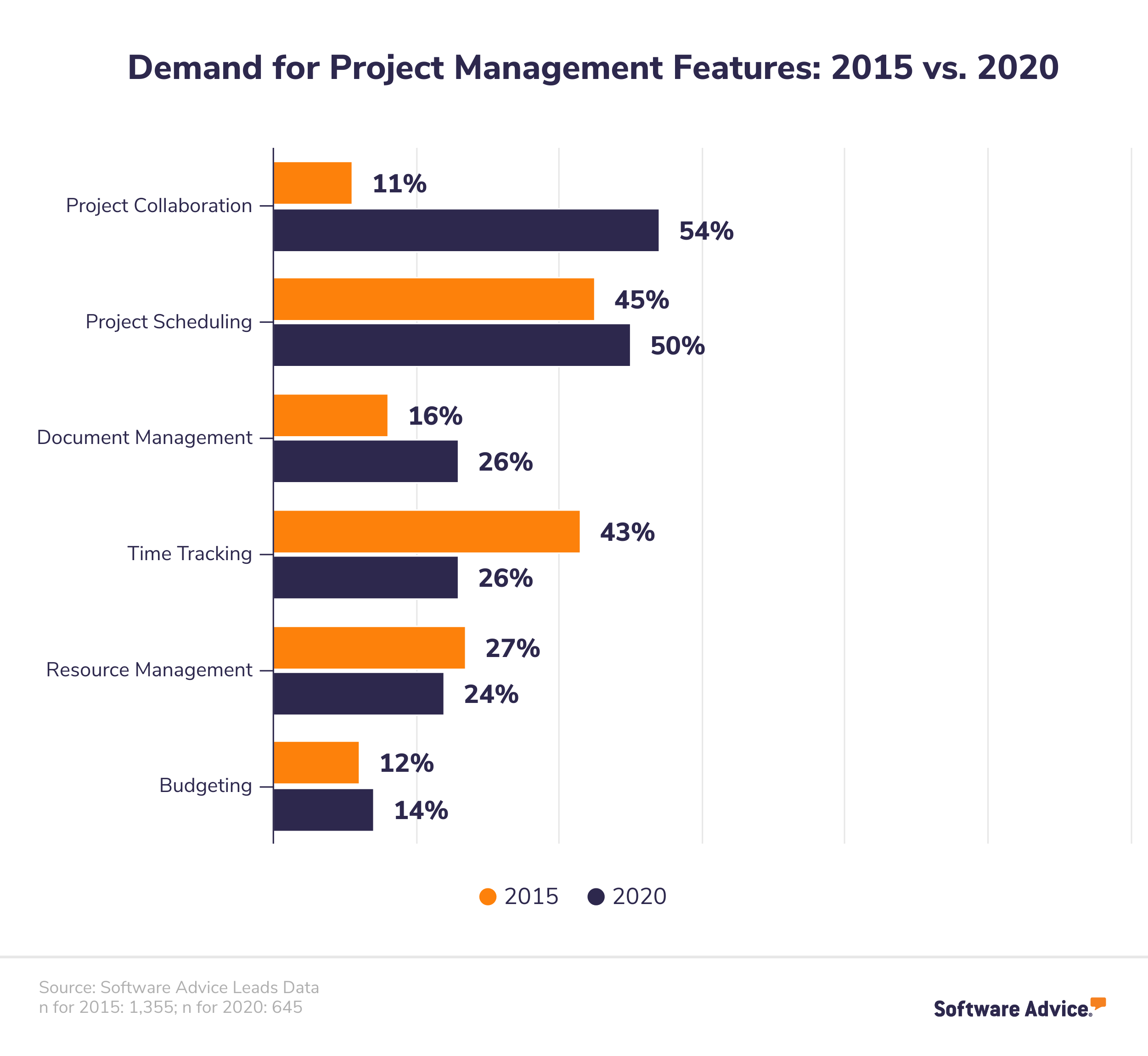
Project collaboration registered a sharp increase in demand
Among all features, project collaboration registered the highest increase in demand over the past five years. In 2015, only 11% of businesses that consulted us requested the feature, while 54% did so in 2020.
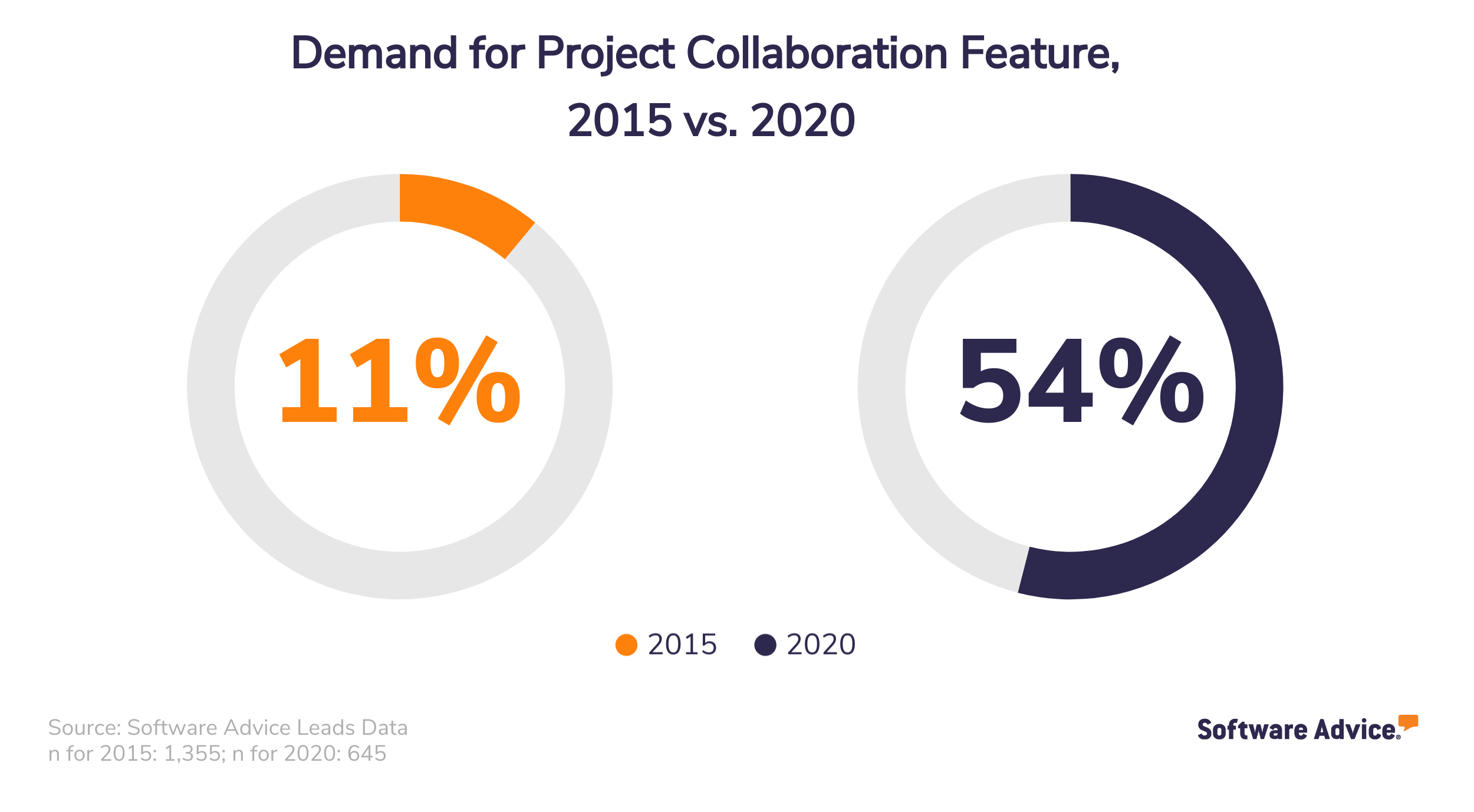
This change can likely be attributed to the fact that projects have become more collaborative than they were previously. Project teams today have members and stakeholders—internal as well as external—across global time zones. Since the project collaboration feature helps ensure efficient communication among team members irrespective of their locations, it has witnessed increasing demand with time.
Our recommendation: Look for a project management tool that lets your team collaborate in real time via live chat, audio and video conferences, live shared workspaces for project docs and resources, and @mentions on project tasks.
Demand for project scheduling grew slightly
While 45% of businesses requested the project scheduling feature in 2015, 50% did so in 2020. Though it was the second-most-requested feature in 2020, there was only a slight jump in demand compared with 2015.
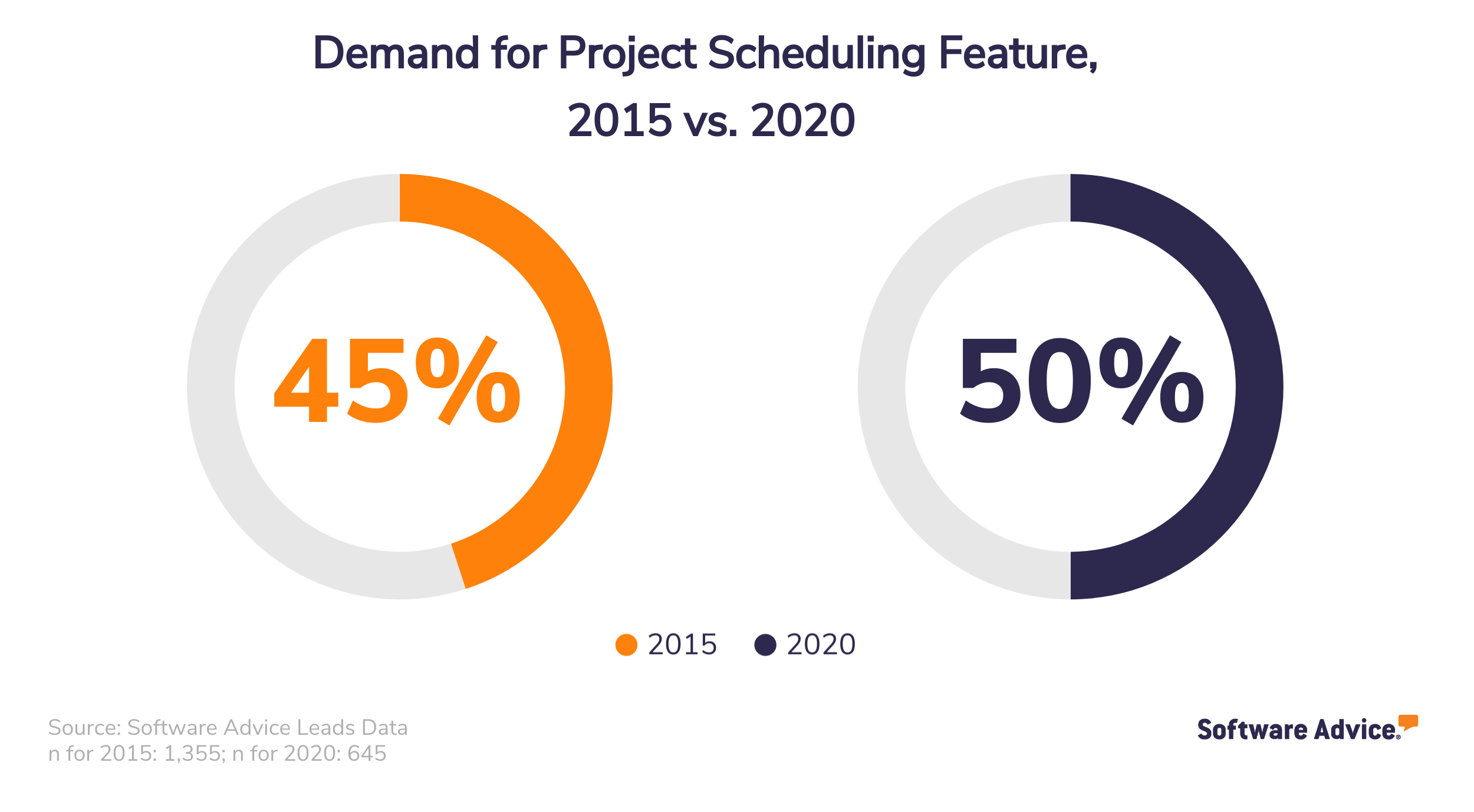
This highlights that scheduling plays a consistently important role in ensuring project success, hence its demand hasn’t changed much. Businesses across industries use this feature to plan project timelines, schedule resources, track progress via real-time dashboards, and ensure timely project delivery.
Our recommendation: Opt for a project management solution that lets you break a large project into smaller milestones or subprojects for easier tracking. Workload management, integrated project calendars, Gantt charts for visualization, linking of dependent tasks, and real-time project notifications are the key features you should select.
Document management experienced healthy demand growth
Project documents such as requirements planning sheets, project plans, resource allocation reports, and status reports are used across the project lifecycle. In 2015, 16% of businesses that consulted us requested the document management feature, while 26% did so in 2020.
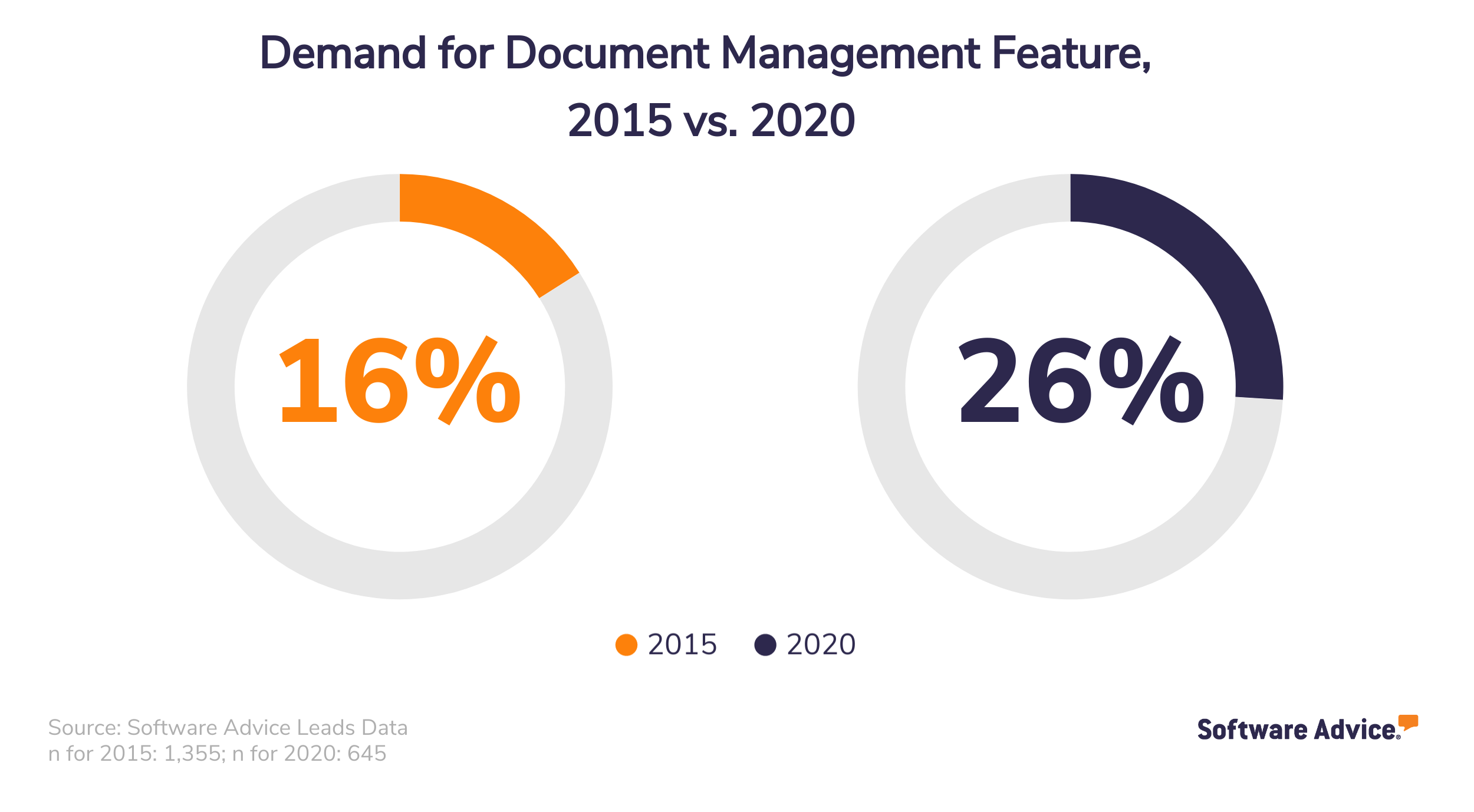
This demand increase coincides with a recent project management trend: paperless documentation. With most businesses now going digital, project teams are relying on software tools to manage documents such as case studies and stakeholder reports. A centralized document repository, dedicated project folders, quick document search and retrieval, and an option to track all changes made to a document are some benefits affecting the positive demand for project document management.
Our recommendation: Invest in a project management platform that lets you arrange documents into different categories; track changes and revisions; define access permissions; and set up a process for document review, approval, and retrieval.
Demand for project time tracking slumped
In 2015, 43% of businesses sought the time tracking feature; the number fell to 26% in 2020. This might come as a surprise in the current business setup where employees across the globe are working remotely. Meetings have moved online, and the general perception is that managers prefer tracking every project hour. But data speaks otherwise.
![]()
Over the years, project leaders have started offering more flexibility to their teams. They want to complete tasks on time, but they’re not keen on micromanaging their project team members. They’re aware micromanagement can be counterproductive and lead to unnecessary stress, especially for a project team working remotely. This is a likely reason for the fall in project time tracking demand over the past five years.
Our recommendation: Use the time tracking feature only for projects or project tasks for which you need to report the exact hours (e.g., projects billed by the hour).
Demand for project resource management contracted marginally
While 27% of software buyers requested resource management functionality in 2015, 24% did so in 2020. Of the requests received in 2020, the most came from manufacturing (17%), software or technology (10%), engineering (8%), financial services (6%), and marketing (6%) businesses.
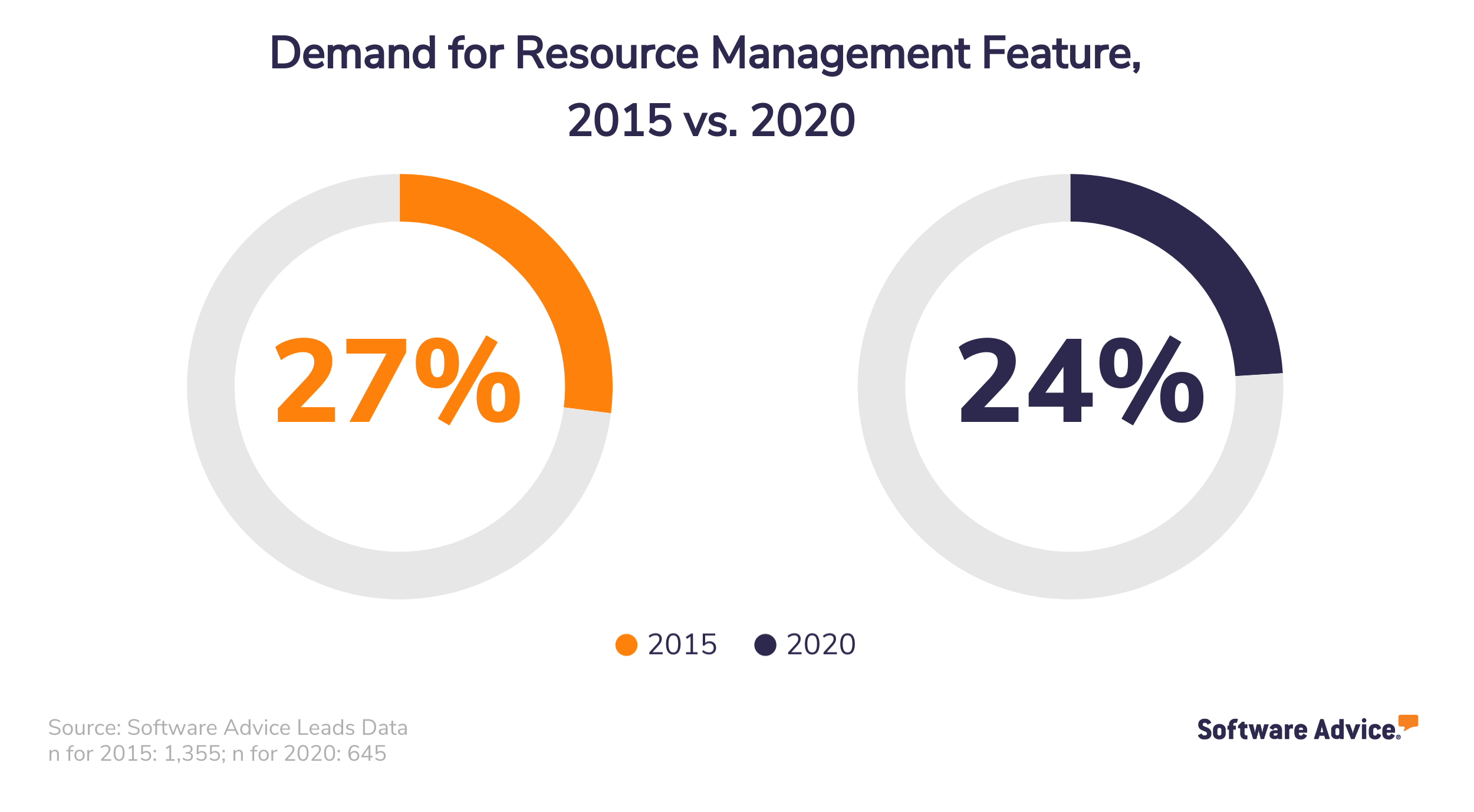
These numbers suggest demand hasn’t changed much over the past five years. Also, the feature is most requested in industries that have a high resource cost—could be for hiring skilled personnel, purchasing expensive inventory, or operating in a niche market segment—and want to purchase software for optimal use of resources (people, materials, and money).
Our recommendation: Consider investing in project resource scheduling if your organization provides specialized services such as legal, IT consulting, or financial planning.
Project budgeting witnessed a small uptick in demand
In 2015, only 12% of software buyers sought the budgeting feature; the number increased to 14% in 2020. The highest demand in 2020 came from manufacturing (11%), non-profit (11%), software or technology (8%), construction (8%), and engineering (7%) firms.
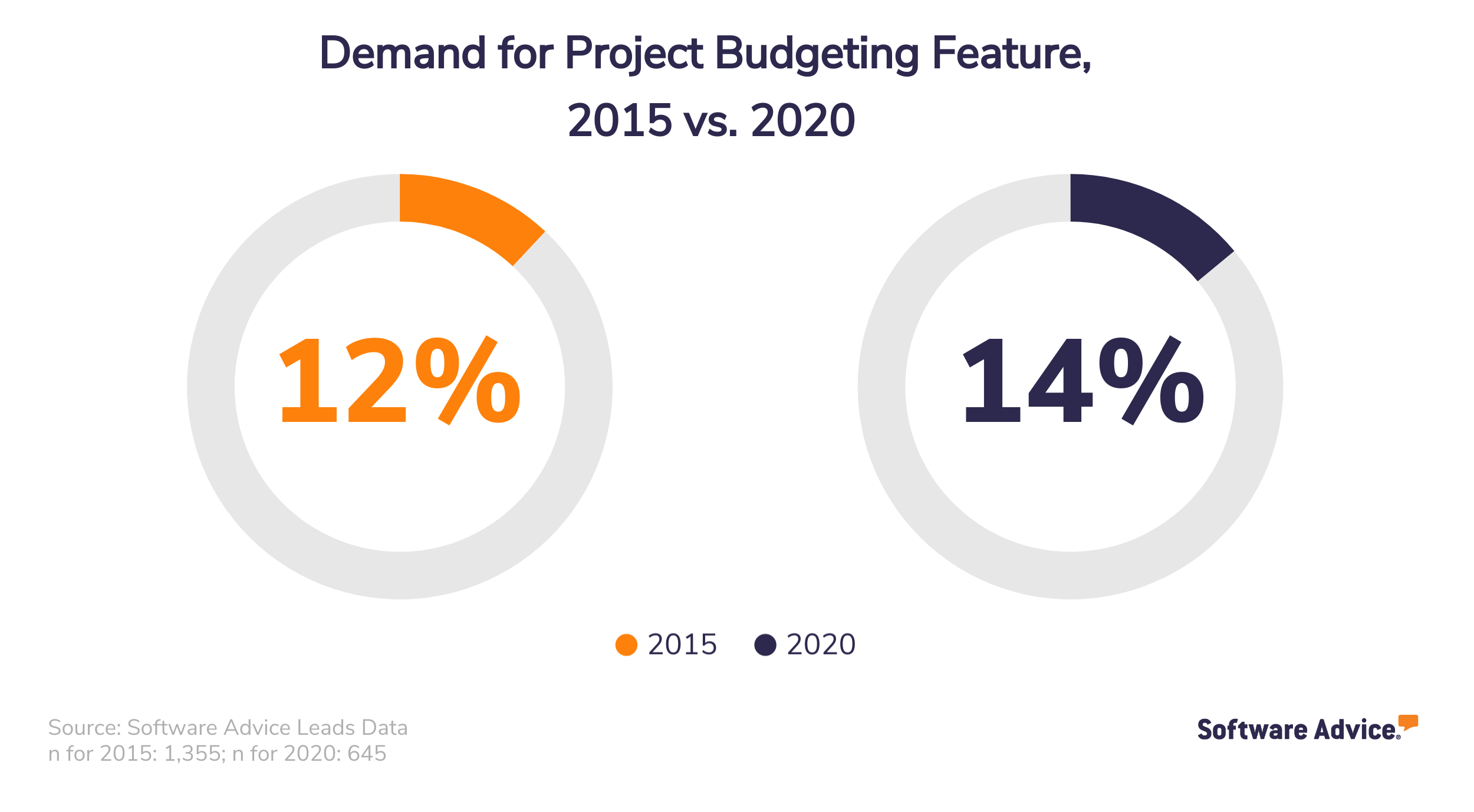
Consistent low demand for budgeting reveals an emerging trend: Most businesses seem to be satisfactorily tracking project budgets using manual methods such as spreadsheets. This is likely a reason adoption is more in industries where projects either have high resource costs or run a risk of exceeding budgets if costs aren’t tracked.
Our recommendation: Consider investing in the budgeting feature if you manage capital-intensive projects that involve multiple project professionals (e.g., software development and construction projects).
Impact of COVID-19 on project management software demand
Despite the remote work trend, demand for project management software features hasn’t varied much in the months following the start of COVID-19. In a sense, the project management software market has consistent buyer demand, with features demand not affected much even during extreme market conditions such as the COVID-19 pandemic.
Here’s a month-on-month comparison of buyer demand for the top three project management functions since the start of the COVID-19 pandemic.
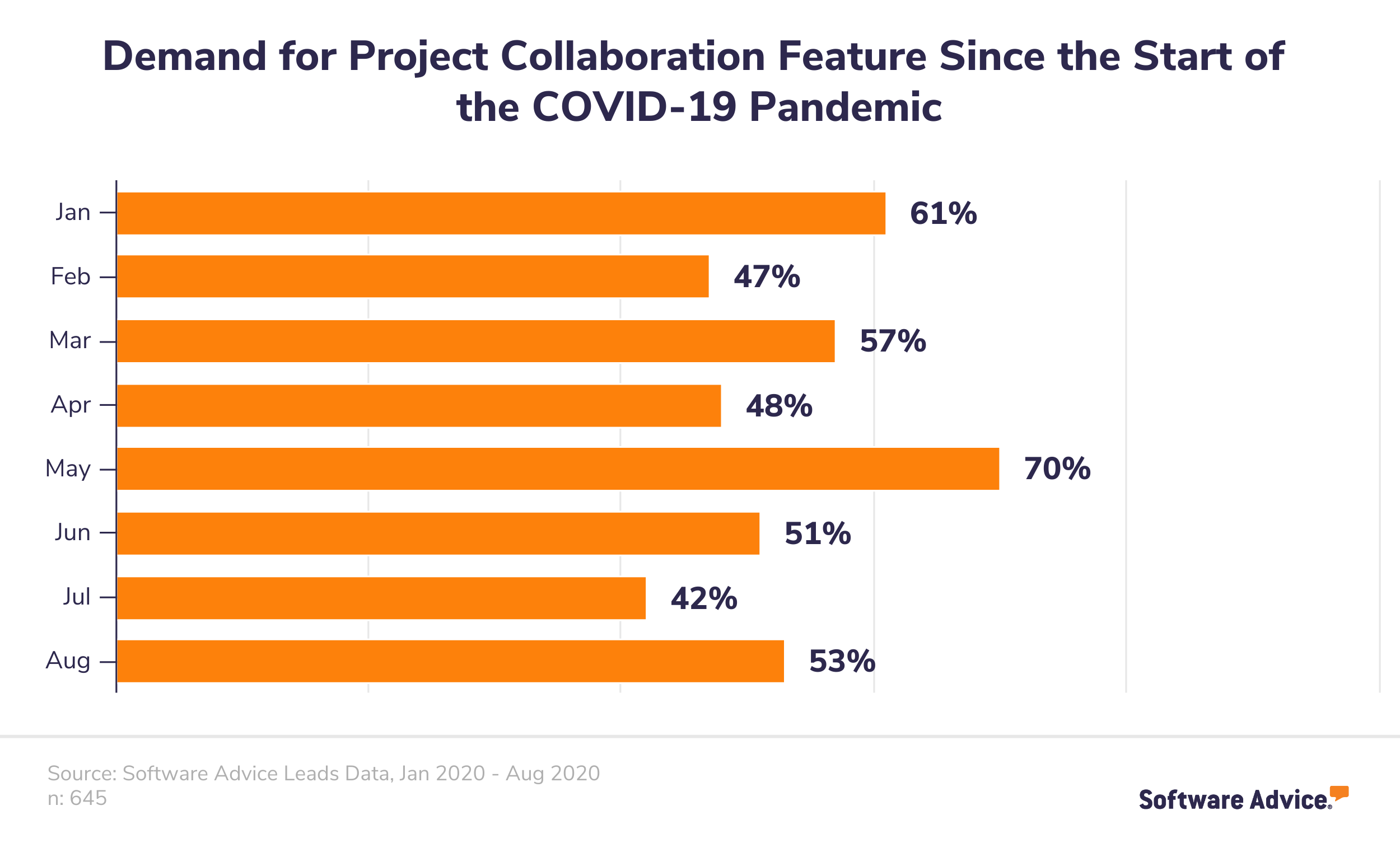
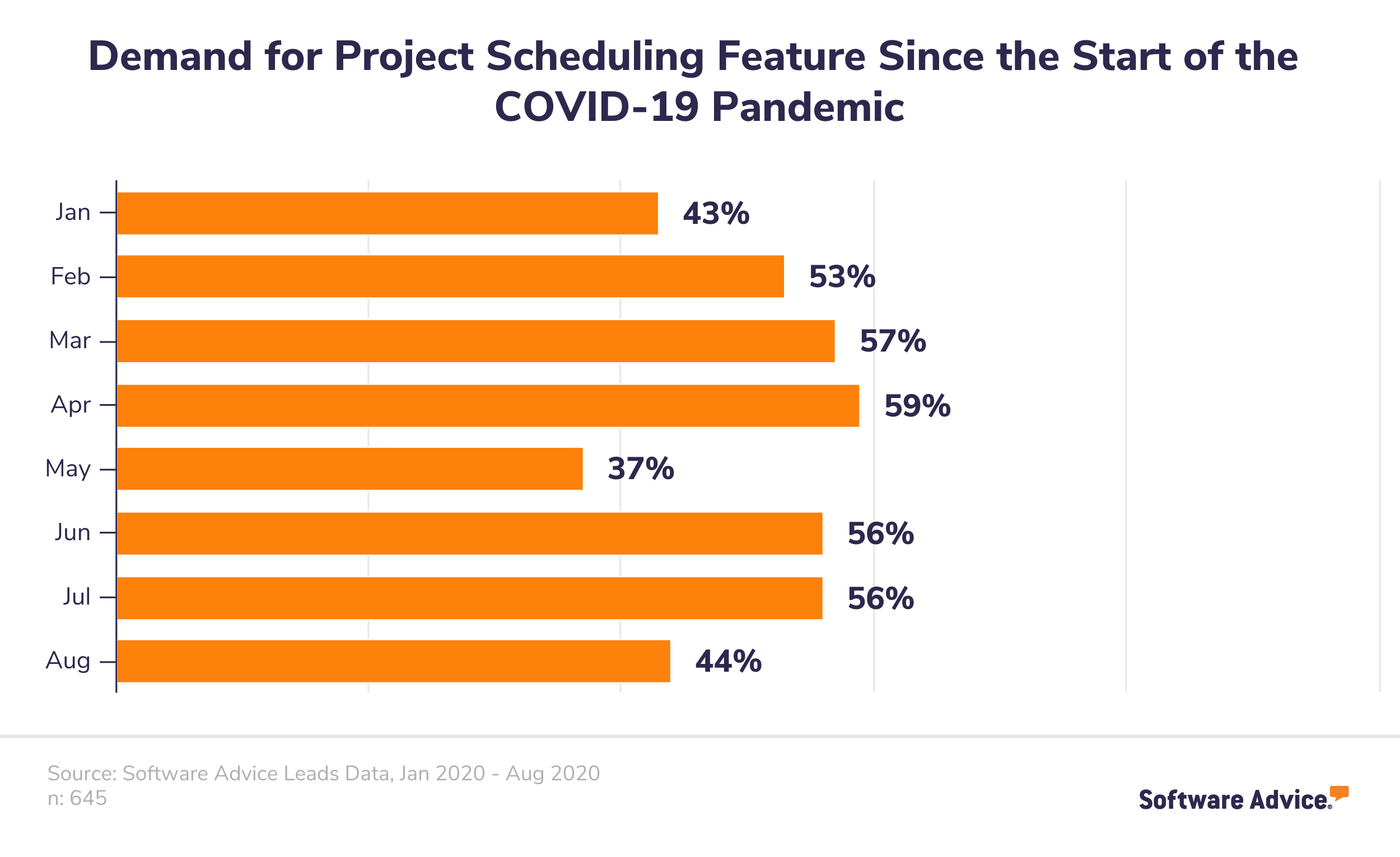
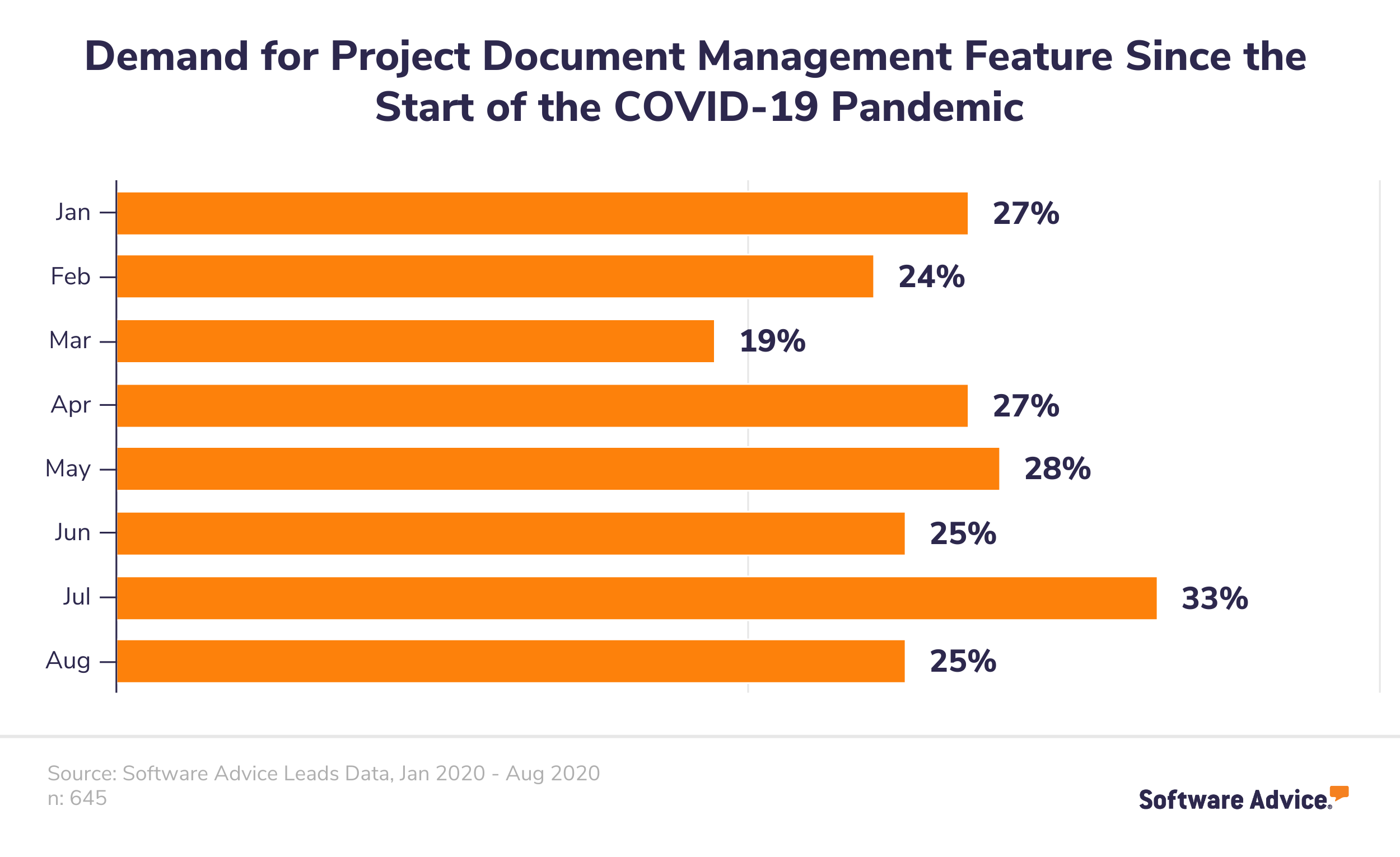
Next step: Evaluate your project management needs
The success of your projects, to a large extent, depends on the software you use. Now that you’re aware of the current project management trends and their impact on buyer demand, the next step is evaluating your business requirements.
If you already have a project management solution, compare the features mentioned in this report against the features of your software, and check if you should upgrade. And if you’re planning to buy new software, ensure you’re using its features to the fullest. Here are some resources to help with your purchase:
Methodology
Our software advisor team regularly chats with people like you who reach out to us for help finding project management software. The data used to create this report was collected by our advisors during those conversations to provide software guidance, rather than for market research. For the purposes of this report, we’ve analyzed 1,355 interactions in 2015 and 645 interactions between January and August 2020. Analysis of these interactions was used to find project management trends and change in software demand over 2015-2020.